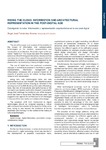Riding the cloud. Information and architectural representation in the post-digital age.

Use this link to cite
http://hdl.handle.net/2183/16883Collections
- Investigacion (ETSAC) [512]
Metadata
Show full item recordTitle
Riding the cloud. Information and architectural representation in the post-digital age.Author(s)
Date
2014Citation
FERNÁNDEZ ÁLVAREZ, Ángel José (2014) "Riding the cloud. Information and architectural representation in the post-digital age". EGE: Revista de Expresión Gráfica en la Edificación, número 8, pp. 159-166.
Abstract
[Abstract] The aim of this paper is an analysis of the evolution of the impact of information and communication technologies on the ideation, representation and construction of architecture. Since the origins of the socalled “digital turn” this issue has been the subject of extensive critical thinking and disciplinary debate and has now become an area of fully operative research which is necessary to achieve a comprehensive approach to the phenomenon by developing a theory of digital design.
The use of digital tools has produced substantial changes in architectural practice in the fields of graphic representation, information management and virtualization processes with a special impact on all aspects of graphic survey for cultural heritage study, research and conservation.
Along with new technological tools are new approaches such as “non-linearity”, the importance given to process instead of form shaping as reflected in the development of the BIM (Building Information Modelling) tools, the role of interactivity and performance or the concept of participatory authorship inherent in parametric design that challenge the traditional role of the designer which has been in force from “the Albertian code” and
suggest a new agenda for architecture full of challenges in the era of the new media and collaborative design.
The paradigm shift from mechanical to digital technologies should be analyzed keeping a critical attitude toward the potential of the digital but at the same time, trying to see beyond the problems of formal aesthetics and framing it in the context of the history of cultural technologies.
Keywords
Digital design
Digital fabrication
Parametric design
Collaborative design
Digital fabrication
Parametric design
Collaborative design
ISSN
1888-8143





